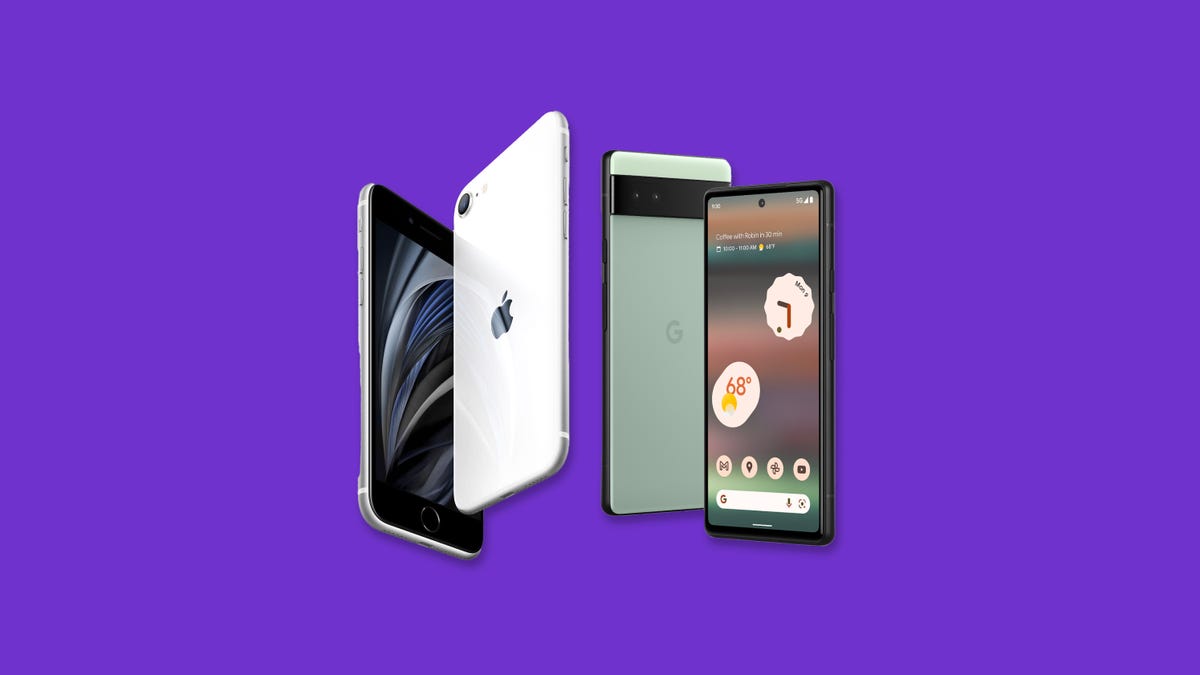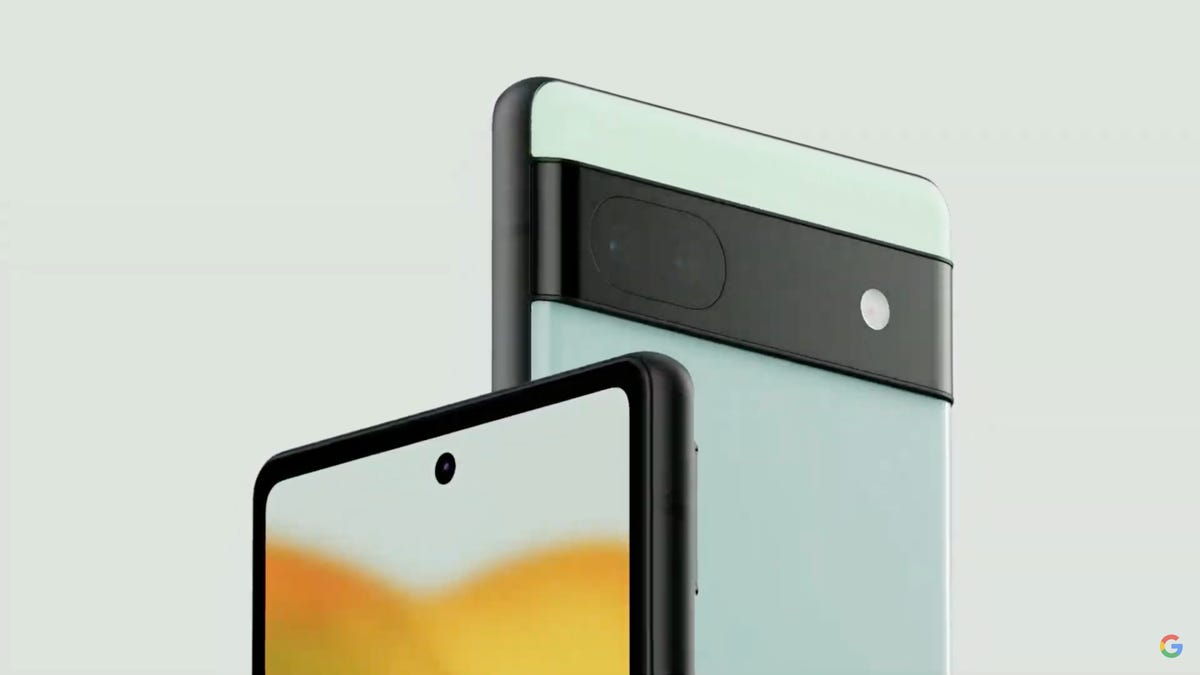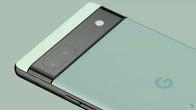Google's $449 (£399, AU$749) Pixel 6A launches July 28, and it's going to take a page from Apple's $429 iPhone SE. The cheaper Android 12 phone is going to keep the same Tensor chip that powers the $599 Pixel 6 -- much like how the iPhone SE includes Apple's latest A15 Bionic chip -- and put it in a slightly smaller phone with a camera that harkens more toward earlier Pixel phones like the Pixel 5A from 2020.
But for many people, this might not be much of a sacrifice and could be worth the cheaper price. The Pixel 6A still includes many of the exclusive features that are provided by Google's Tensor chip, including the Magic Eraser that lets you remove people or objects from photos.
Let's go over some of the key differences, including its screen, design, cameras and software.

Apple's iPhone SE and Google's Pixel 6A. Both phones include the latest processor from each respective company in a smaller design.
Apple/Google/CNETScreen and design
When it comes to the Pixel 6A's looks, you could be forgiven for confusing it with the more expensive Pixel 6. Both phones have a two-tone color design on the back, flanked by a camera bar. That camera bar is as striking on the 6A as it was when the Pixel 6 debuted in November.
Coming around to the front of the 6A, the phone includes a 6.1-inch OLED 1080p screen which is locked to a 60Hz refresh rate. Compared to the Pixel 6, this is slightly smaller than its 6.4-inch OLED 1080p screen which can run at 60Hz or 90Hz. Material-wise, the Pixel 6A's screen will be covered with Corning's older Gorilla Glass 3 instead of Corning's newer Gorilla Glass Victus that's on the Pixel 6.
The phone also includes an in-screen fingerprint reader, and while we haven't had hands-on time with the phone yet, the fingerprint reader is rumored to be faster than the Pixel 6's fingerprint reader. And while it doesn't affect the phone's appearance, the Pixel 6A's body lacks wireless charging while the Pixel 6 does include it.

The cameras on the Pixel 6A are within the camera bar on the rear and in the top-center of the screen on the front.
GoogleCameras
The Pixel 6A's biggest differentiator from the Pixel 6 will likely be in its camera. While the Pixel 6 steps up with a 50-megapixel wide camera alongside a 12.2-megapixel ultrawide, the Pixel 6A will include a 12-megapixel wide camera and 12-megapixel ultrawide camera. This isn't a bad thing, as this setup largely mirrors the cameras included on the Pixel 5A.
Both the Pixel 6A and the Pixel 6 include the same 8-megapixel front-facing camera
The Pixel 6A will also make use of its Tensor chip to enhance photos, which will include its Real Tone skin tone feature, Face Unblur to sharpen up an otherwise blurry image, Night Sight for photography in darker locations and the Magic Eraser, which will be updated to allow for tweaking the color of objects inside of a photo.
Many of these camera features will come with the Pixel 6A's implementation of Android 12, which will largely mirror the Pixel 6.

The Pixel 6A will be available in charcoal, chalk and sage colors.
GoogleSoftware
The Pixel 6A and the Pixel 6 in terms of software will be largely identical to each other, with both phones shipping with Android 12 and its Material You color customizations. The Pixel 6A will also join the Pixel 6 and 6 Pro in being among the first phones to get updated to Android 13 when its public release arrives later this year.
One hardware related note though that could affect multitasking: The Pixel 6A includes 6GB of RAM versus the 8GB included in the Pixel 6. For most people, 6GB is going to be plenty of memory for daily tasks, but it's worth the callout that the Pixel 6 should be able to tackle slightly more.
We've listed out more spec by spec comparisons in this chart comparing both phones.
Pixel 6A vs. Pixel 6
| Google Pixel 6A | Google Pixel 6 | |
|---|---|---|
| Display size, resolution | 6.1-inch OLED (1,080x2,400 pixels); 60Hz | 6.4-inch OLED (2,400x1,080 pixels); 60 or 90Hz |
| Pixel density | 429 ppi | 411 ppi |
| Dimensions (Inches) | 6.0 x 2.8 x 0.35 in | 6.2 x 2.9 x 0.4 in |
| Dimensions (Millimeters) | 152.2 x 7.18 x 8.9 mm | 158.6 x 74.8 x 8.9 mm |
| Weight (Ounces, Grams) | 6.3 oz; 178g | 7.3 oz; 207g |
| Mobile software | Android 12 | Android 12 |
| Camera | 12.2-megapixel (wide), 12-megapixel ultra wide) | 50-megapixel (wide), 12-megapixel ultrawide |
| Front-facing camera | 8-megapixel | 8-megapixel |
| Video capture | 4K | 4K 30, 60fps (rear), 1,080p 30fps (front) |
| Processor | Google Tensor | Google Tensor |
| RAM/Storage | 6GB RAM/128GB storage | 8GB/128GB, 256GB |
| Expandable storage | None | No |
| Battery/Charger | 4,410 mAh capacity; 18-watt fast charging (adapter sold separately) | 4,614 mAh |
| Fingerprint sensor | Under display | In-display |
| Connector | USB C | USB-C |
| Headphone jack | None | No |
| Special features | 5G-enabled, 18W fast charging, Wi-Fi 6E, security updates for 5 years, Android OS updates for 3 years, dual SIM, IP67 water-resistance | 5G sub 6 (some carrier models also have 5G mmWave) support, Wi-Fi 6E, 30W fast charging, Magic Eraser, Motion mode, Real Tone, Face Unblur, Cinematic Pan, 5 years OS and security updates, IP68 rating for dust and water resistance, Gorilla Glass Victus (front), Gorilla Glass 6 (back) |
| Price off-contract (USD) | $449 | $599 (128GB) |
| Price (GBP) | £399 | £599 |
| Price (AUD) | A$749 | AU$999 |
Google Pixel 6A vs. Pixel 6: What's Different About Google's Cheaper Android 12 Flagship - CNET
Read More


No comments:
Post a Comment